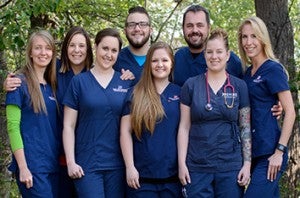
Boise State respiratory care students are making a name for themselves in the Northwest as “head and shoulders above graduates of other programs,” according to a recent glowing review of students on clinical rotation at Seattle Children’s Hospital in Seattle, Washington.
Respiratory care practitioners treat, manage and control patients’ breathing in medical settings. As part of their education, respiratory care students spend time working in medical settings — such as neonatal intensive care units or adult critical care units — in Boise and around the Northwest so that they can observe professionals in their field and practice caring for patients.
In these settings, students are able to explore many sub-specialties in the field, including pulmonary function testing, home care, sleep studies and pulmonary rehabilitation. Equally importantly, they work with mentors who help them make the vital transition from students to practitioners.
Boise State students already have earned a reputation locally for their knowledge, professionalism and competency, and as eight students’ recent out-of-state clinical rotations prove, that reputation is spreading across the Northwest.
During the fall semester of 2014, the Boise State respiratory care program was contacted by the University of Washington Medical Center in Seattle regarding recent program graduates.
“They have hired our graduates in the past and were so pleased with their performance that they not only wanted to hire more Boise State graduates, they also wanted them to complete clinical rotations at their facility,” explained Jeff Anderson, director of clinical education in the Department of Respiratory Care. Other medical centers expressed an interest in hosting Boise State students, including Seattle Children’s Hospital and Randall Children’s Hospital at Legacy Emanuel in Portland, Oregon.
During these rotations, students were able to observe, and in some cases participate in, the care of patients utilizing procedures that are currently not performed in Boise hospitals, such as partial liquid ventilation (a procedure seemingly straight out of science fiction that involves injecting a dense liquid into the lung that is able to retain large amounts of oxygen, and then using a ventilator to “breathe” for the patient) and extracorporeal life support (a technique performed on diseased lungs in which blood is diverted from the body into a device that filters out carbon dioxide and replaces it with oxygen, essentially creating an out-of-body artificial lung).
The Boise State respiratory care faculty say students owe a great deal of gratitude to the Boise area respiratory care practitioners who serve as clinical preceptors and help them develop the quality of graduates that garners this type of recognition.
“Feedback from the facilities and from the students has been outstanding, and we plan to continue to offer this opportunity during future spring semesters,” Anderson said. Along with Seattle Children’s Hospital’s glowing review, another clinical site reported that “the students are an ideal example of what we need in future RTs.”